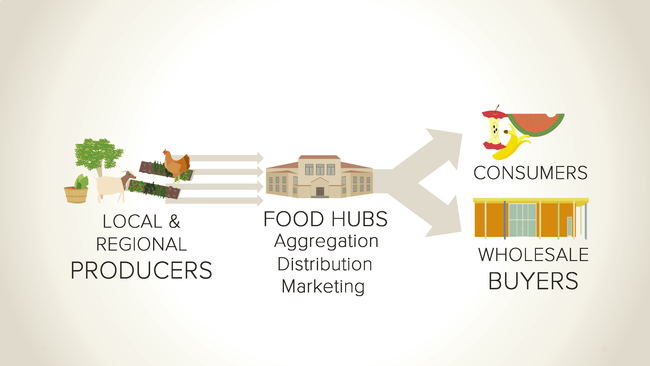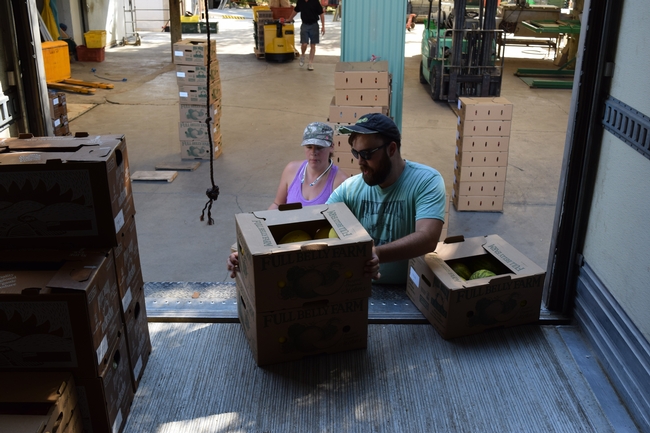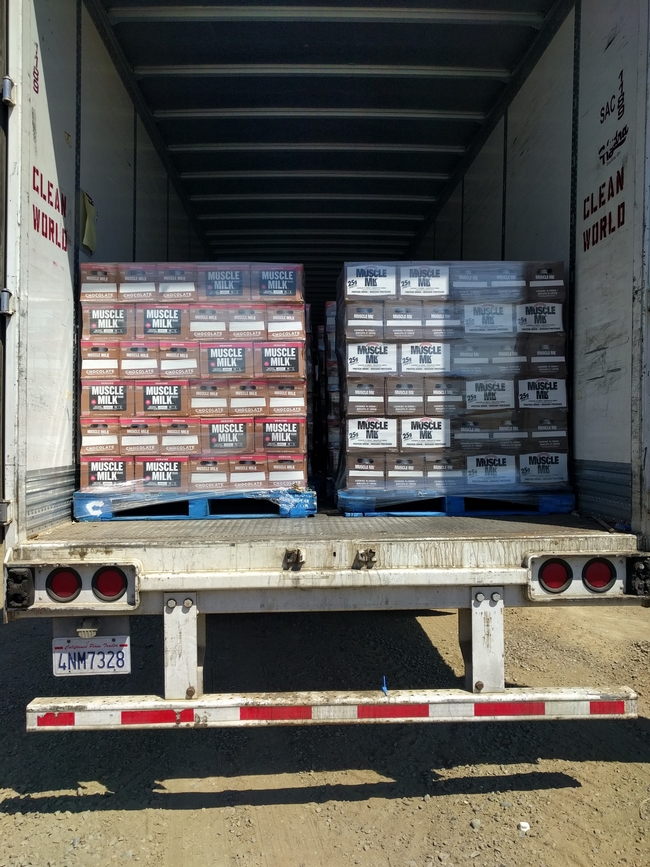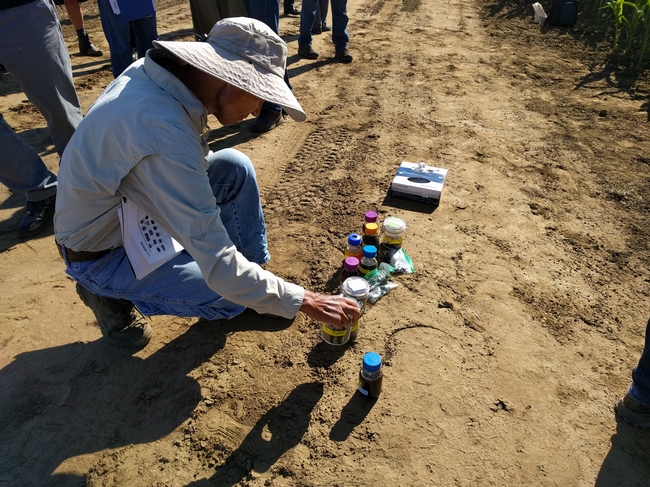Posts Tagged: Sustainable Food Systems
#Collabatition: A new network of food hubs looks past competition to help each other succeed
In today's food system, large scale food distribution has become the standard way food moves from farm to market. The system works well to feed a lot of people, and has allowed us to eat tomatoes in December and send produce far distances while keeping it fresh. But the system is not without its sacrifices.
Through large scale food distribution, farmers can lose the ability to set their own prices, and small-scale farmers can be cut out from the system for not being able to fill high volume orders. On the consumer side, this system can make local food harder to find and identify. Institutions interested in providing locally grown produce at their cafeterias may need the efficiency buying from large distributors provides, but find they're unable to source food the way they'd like.
Food hubs are businesses popping up around California and the U.S. trying to create a food distribution system that supports regional food systems. By aggregating food from small and mid-sized farms and selling it to large businesses and institutions, food hubs are able to help realize the consumer's desire for local food while helping small and mid-sized farmers succeed by connecting them with buyers who may otherwise be out of reach.
To help ease the challenge of starting these unique businesses, a network of food hubs in California, organized by the UC Sustainable Agriculture Research and Education Program, is learning how to conquer their business start-up and growth challenges together.
Food hubs as business innovators
Thomas Nelson, president and co-founder of Capay Valley Farm Shop, a food hub in California's Capay Valley, has built his business around a vision of a thriving regional food system where small farmers succeed. Thomas purchases food from 50 different farms in and near the Capay Valley, and sells primarily to corporate food service in the Bay Area.
“Our model is farmer-focused," Thomas said. “Farmers set the price for their food, and we add on our margin. We help tell the story of the farms so that their identity is kept throughout the supply chain. We let our buyers know about new products or new farms we're working with, and our buyers ask for produce by farm name.”
Thomas works closely with his 50 farmers, helping them plan their crops to best meet the demands of their clients, and working with the beginning farmers to get them through the hurdle of learning how to sell wholesale.
“It can be a challenge to accurately predict the next harvest,” Thomas said. “And it's our responsibility to mitigate some of those risks for the buyers as much as possible, but our buyers also get it. The reason they choose to work with the food hubs is they want to support local farms. What really makes this work are shared values.”
#Collabatition
Thomas is one member of a new statewide food hubs network created in collaboration with the UC Sustainable Agriculture Research and Education Program (UC SAREP), a statewide program of UC Agriculture and Natural Resources whose work includes improving marketing opportunities for small farmers. The network, funded in part by the UC Global Food Initiative, brings together food hub mangers to learn from one another and collectively pave the way for successful food hubs in California.
The food hub business model is a relatively young one, few food hubs existed in the United States before 2008. Today, hundreds are in business across the country, and they're all trying to figure out similar things: how to best work with farmers and customers to make the business model effective, how to run a food business in a regulation-laden environment, how to increase efficiency without sacrificing price, quality, and the value of local agriculture.
“Food hubs are really working with farmers in their local areas to help them reach markets beyond selling directly at the farmers' market,” said Gwenaël Engelskirchen, who leads the food hub projects at UC SAREP. “We brought a group of northern California food hubs together for their first convening in February of 2015 and they realized that they all had a lot to learn from each other. They realized that there's opportunity in them working together.”
There's a hashtag on Twitter for what they're doing: #collabatition, or, collaborating with your competition. UC SAREP acts as the organizing body for the food hub network — coordinating resources to help the hubs wade through the many rules and regulations of operating a food business, and working through the visions of their own businesses and the network collectively.
“This is a newish space, so there is a ton to learn and share,” Thomas said. “By having a network we are supporting each other on the journey of growing successful businesses that serve local farms and regional buyers. Working with UC SAREP, we can have conversations with larger buyers that would be hard for us independently to access.”
One of those potential larger buyers is an organization close to home — the kitchens of the University of California.
“UC SAREP plans to interview kitchen directors from UC campuses all around the state to see what keeps them from buying local food, and whether the food hub business model is one that can support the desire they have to incorporate local food into their kitchens,” Gwenaël said.
And past successes show that food hubs can play an important role in linking UC dining programs with local farms. According to a recent report from the UC Global Food Initiative, through a relationship with the food hub Harvest Santa Barbara, UC Santa Barbara is currently able to source 23 percent of its produce from within 150 miles of campus.
“By linking UC food buyers with food hubs, we want to see if that success can be replicated around California," Gwenaël said. "In 2014, UC Santa Barbara alone served nearly three million meals, so the entire UC becoming a local produce buyer could be a major boon to regional food systems.”
The UC SAREP website offers a number of resources that can assist food hubs as well as farmers looking to see their produce wholesale. Find those resources here. Stay tuned for an upcoming article on food hubs in the next issue of California Agriculture journal.
Biodigesters turn food into electricity, but can they also create fertilizer?
On a recent late-summer Wednesday, a freight container filled with cases of expired Muscle Milk protein drink awaited unloading at the UC Davis Renewable Energy Anaerobic Digester (READ) while a front-loader scooped heaps of spoiled vegetables into a mechanical processor. Nourished by a diet of assorted food waste from the UC Davis campus and area restaurants and markets, READ harnesses the activity of billions of microbes to produce biogas capable of generating 5.6 million kWh per year of clean electricity for UC Davis.
But a by-product of READ and other anaerobic digesters – the slurry of leftover solid and liquid material, or digestate – has caught the attention of UC Davis researchers interested in “closing the loop” on food production, consumption, and waste. When processed through an anaerobic digester, organic materials like food discards, expired or off-spec food products, or animal manure can be transformed into concentrated biofertilizers and soil amendments that are highly effective and easily applied to crops.
In an interdisciplinary collaboration at the Russell Ranch Sustainable Agriculture Facility, funded by the California State Water Resources Control Board and the California Department of Food and Agriculture, UC Davis faculty and students have developed a pilot-scale process for commercial production of several forms of this biofertilizer using digestate from READ and other nearby digesters. They are also evaluating their effects on yield and other agronomic metrics in corn and tomato field trials – paving the way for farmers and growers to take advantage of a highly sustainable source of plant nutrition.
The challenge and opportunity of fertilizer from anaerobic biodigesters
The digestate from READ and other digester facilities can be applied directly to soil as a fertilizer, but, because it has a limited shelf-life, it usually must be applied to land in the immediate region of the facility. With the input of food waste that can vary widely from day to day, a facility's digestate is inconsistent in texture and composition, making it difficult to transport and apply to fields using common farm fertilizer equipment.
Filtering and drying this digestate, however, results in solid and liquid forms that can be concentrated, homogenized, easily transported, and applied to soil through existing drip irrigation systems or surface spreading equipment.
This process could allow farmers and growers located further away, and working with common irrigation and fertilizer application equipment, to supplement or replace their synthetic fertilizer consumption with biofertilizers from food waste or animal manure.
How do biodigestate products measure up to synthetic fertilizers?
The research, co-led by professor Ruihong Zhang from the UC Davis Department of Biological and Agricultural Engineering (who also designed READ in partnership with Sacramento-based tech company CleanWorld) and Professor Kate Scow from the Department of Land, Air, and Water Resources, developed pilot-scale systems to efficiently and consistently separate the solid and liquid portions of food- and manure-based digestates. The researchers then examined the nutrient composition of the solid and liquid biofertilizer products, finding that biodigestate-based fertilizers contain valuable nutrients and microbes not found in many synthetic fertilizers.
In current field trials, the researchers are investigating the effects of each of the biofertilizer products on crop yield and quality. Their preliminary results show that it is possible to grow irrigated processing tomatoes and short-season corn using biofertilizer products as the sole source of fertilizer. The origin of the fertilizer matters, however – manure-based liquid fertilizer formed additional large particles after the final filtration, creating concerns about clogging the drip irrigation system. The team thinks an environmentally benign chemical sometimes added to manure digesters to clean the biogas may be the culprit of the problem, but future research is needed. The solid biofertilizer pellets they developed show much promise, as they can be applied using existing methods for spreading compost and can be economically transported farther away from the digester.
In addition to better understanding the best processes for producing and using the biofertilizers, further research is needed to understand how much of the nitrogen in each of the fertilizer products is available for uptake by the crop, as well as economic analyses to determine the commercial-scale production and transportation costs. The researchers will be able to narrow in on the agronomic and economic potential of biofertilizers through the upcoming analysis of the yield of the corn and tomato experiment plots at Russell Ranch. The results of a tomato experiment recently showed that the digestate fertilizers produced just as much fruit as a popular synthetic fertilizer.
Interdisciplinary research for agricultural innovations
Russell Ranch, a program of the Agricultural Sustainability Institute, is designed as a shared space for interdisciplinary research and innovation. The biofertilizer research, among other active projects at Russell Ranch, is an example of the fulfillment of that intention. “The soil scientists are learning engineering, the engineers are learning biology, and the biologists are learning about soil,” Professor Zhang remarked.
The exchange also extends beyond the university: a recent UC Davis Biofertilizer Field Day drew attendees from the UC Division of Agriculture and Natural Resources, several public agencies, the agricultural sector, other universities, nonprofits, entrepreneurs, and food processors. If the research continues to illuminate a way forward for biofertilizers, these audiences may fill important roles in bringing this new technology into practice – and in recycling your lunch leftovers back into a more efficient and sustainable food system.
More information: UC Davis READ, Russell Ranch, and the biofertilizer research
The UC Davis Renewable Energy Anaerobic Digester was unveiled in 2014 as the nation's largest anaerobic biodigester on a college campus, and represented a unique private-public partnership. Professor Ruihong Zhang invented the anaerobic digestion technology used by CleanWorld, which developed it into one of the most advanced commercially-available digester systems in the country.
Russell Ranch Sustainable Agriculture Facility is a “living laboratory” for interdisciplinary field research and innovation. Its flagship project, the Century Experiment, measures the long-term impacts of energy, water, carbon, and nitrogen inputs on agricultural sustainability in the flagship Century Experiment.
The biofertilizer research collaboration includes Zhang Lab graduate students Tyler Barzee and Hossein Edalati, Scow Lab postdoctoral researcher Daoyuan Wang, and Russell Ranch manager Israel Herrera. Collaborating institutions include CleanWorld, California Bioenergy, New Hope Dairy (Galt, CA), Fiscalini Dairy (Modesto, CA), and Sacramento Municipal Utility District.
This story en español.





